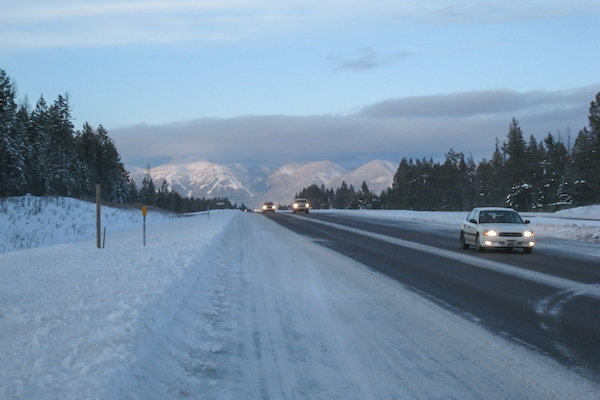Do You Need a Car with All-Wheel Drive to Brace the Snow? Or Just Winter Tires?
AWD: Necessity or Pleasure?
At the tail-end of 2014, popular money-saving blog Mr. Money Mustache posted an in-depth examination on the common All-Wheel Drive VS. Four-Wheel Drive debate, in a piece dubbed “All Wheel Drive Does Not Make You Safer.”
An excerpt:
“All wheel drive is a performance feature, not a safety feature. With all other things being equal, AWD lets you accelerate more quickly on slippery roads. This is usually a bad thing, because it masks the true slipperiness of the road from you, leading to overconfidence which will put you into the ditch, courtroom, or emergency room. But it is useful if you need to plow through unusually deep snow in conditions that would normally get you stuck (for example a steep snowy driveway, or if you run a snow plow). It’s also useful on extremely steep unpaved roads or in areas with no roads at all – places you are unlikely to need a car.”
Many other experts also seem to agree that while AWD is a helpful feature that improves traction, it isn’t exactly necessary either, especially for people who reside in suburban areas.
 There’s also the cost. Potential car shoppers looking into vehicles with either AWD or 4WD (four-wheel drive) might be surprised to find that there’s an often a $2,000 premium that accompanies vehicles with AWD. Cars with AWD are also substantially heavier, with up to hundreds of pounds of gears, lubricating oils, steel shafts, and reinforcements needed. The feature also leads to pricier bills every time you fill up on gas – though, at least, we’re seeing the cheapest gas prices in years.
There’s also the cost. Potential car shoppers looking into vehicles with either AWD or 4WD (four-wheel drive) might be surprised to find that there’s an often a $2,000 premium that accompanies vehicles with AWD. Cars with AWD are also substantially heavier, with up to hundreds of pounds of gears, lubricating oils, steel shafts, and reinforcements needed. The feature also leads to pricier bills every time you fill up on gas – though, at least, we’re seeing the cheapest gas prices in years.
You should also keep in mind, if you’re looking to buy AWD only due to winter-safety reasons (click here for some of our safe winter driving tips), that neither 4WD or AWD help improve braking or even sometimes handling. What is, however, the most important factor in affecting traction during the wintertime? Tires.
Winter Tires – God’s Gift to Drivers
In November of 2013, U.K.-based AutoExpress sought to discover if AWD was indeed a mandatory trait for those drivers who live in rainy, snowy areas, or if a solid pair of winter tires were actually more responsible for reduced traction:
As you can see, the car that had both AWD AND winter tires was crowned champion. But you'll also notice that, when equipped with winter tires, the 4WD car did surprisingly well. Essentially, the clip demonstrates that, if you're living in an area where you're confronted with snow on the regular, then dishing out a little extra for a car with AWD is indeed your best route for getting around that slippery terrain as easy as possible. But for everyone else, including us in the Greater Toronto Area where roads are often cleaned and cleared of snow before your morning commute, spending that extra money on a one-time payment of winter tires seems to be the more practical, and effective, choice. In any event, make sure your car is equipped, protected, and ready for the harsh winter ahead. For most of us who drive in the city, AWD is not usually a crucial factor in getting around. But in any event, sales of AWD cars have been rising steadily throughout Canada as more and more Canadians are taking advantage of this budding technology. According to Matt Wilson, product planning manager for BMW Group Canada, AWD has recently shifted from being viewed as a "safety feature" to a "performance" feature. “BMW has historically been a rear-wheel-drive company,” he explains, “and we still offer RWD on many of our models. The move to AWD — or xDrive as we call it at BMW — has been very quick … It’s built momentum in the last five to seven years. There are very few vehicles we sell that aren’t AWD.” Wilson, however, also maintains that AWD does not provide a way to battle against winter driving conditions if not properly paired with winter tires. The two work best together to boost your car's capabilities in the snow. And then, of course, there's other things you can do as a driver to ensure you avoid any collisions this winter, like keeping a well-stocked emergency kit, or making sure your breaks are up to snuff. Also, you should also remember to....
Wilson, however, also maintains that AWD does not provide a way to battle against winter driving conditions if not properly paired with winter tires. The two work best together to boost your car's capabilities in the snow. And then, of course, there's other things you can do as a driver to ensure you avoid any collisions this winter, like keeping a well-stocked emergency kit, or making sure your breaks are up to snuff. Also, you should also remember to....
Slow Down
As we mentioned earlier, AWD oft comes with extra weight. Extra weight also means it's more difficult to handle your car and change directions, not to mention making you more dangerous to your fellow drivers on the road with you. According to Hayato Mori, manager of product planning at Honda Canada:“AWD systems work very well as long as, a) the tires have grip, and b) the vehicle is travelling at a velocity that does not overcome the grip. Once one or both rules are broken, what you end up with is a very heavy vehicle … that starts to follow Newton’s Law of Motion. AWD is not a substitute for snow tires and the object in motion will want to keep moving unless an equal or greater force acts upon it. All of those SUVs in ditches: [Their drivers] likely broke one or both rules. An SUV going too fast in slippery conditions without snow tires is just waiting to slide off the road.”To reiterate, no matter what the vehicle, no matter what the winter tire you're driving on, you always have to slow down when driving in the snow. No way to get around it. At Auto Loan Solutions, we have access to both AWD and 4WD cars, and offer our customers a customized package that includes the vehicle that's right for them. If you're saddled with poor credit, though, we do recommend for those in suburban areas to choose 4WD and buy winter tires. As a less expensive option, it frees up more funds to spend on paying back your debt (auto loan, credit card, line of credit, etc.) responsibly, in order to reestablish your credit score. If you have a friend who's battling the 4WD VS. AWD decision, share this post with them! While you’re at it, make sure to like our page on Facebook, where our community members post tips about winter driving, maintenance, and more.






